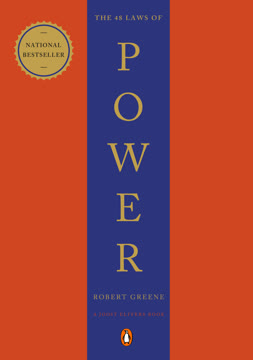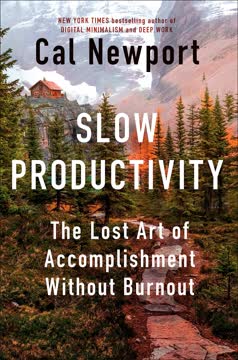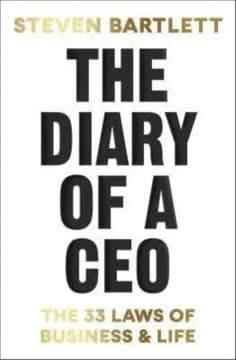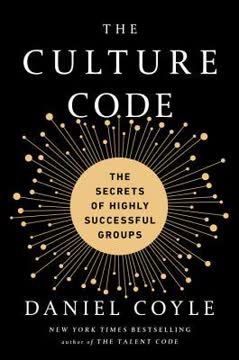Key Takeaways
1. The Language of Leadership: Winning the Instinctive, Emotional, and Logical Minds
Leadership is an emotional contract. The leader meets people's emotional needs. In return for that, the leader gains their support.
The Three-Part Brain. The human brain consists of three main parts: the instinctive, emotional, and logical minds. Great leaders understand how to appeal to each:
- Instinctive mind: Focuses on safety and rewards
- Emotional mind: Deals with feelings and connections
- Logical mind: Processes information and reasoning
Leadership Communication Model. To effectively communicate and lead, follow this sequence:
- Win over the instinctive mind through appearance and body language
- Engage the emotional mind through storytelling and empathy
- Appeal to the logical mind with well-structured arguments and rhetorical devices
By addressing all three parts of the brain, leaders can create a powerful connection with their audience, inspiring trust, motivation, and action.
2. Metaphors: Powerful Tools for Shaping Perception and Influencing Thought
Metaphors plant ideas deep in the instinctive mind, where they take root and grow, spreading around, affecting the way people think, feel and act.
The Power of Metaphors. Metaphors are not just literary devices; they are fundamental to how we understand and perceive the world. They can:
- Shape our understanding of complex concepts
- Influence our emotional responses
- Guide our decision-making processes
Effective Use of Metaphors. Leaders can harness the power of metaphors by:
- Choosing metaphors that align with their message and values
- Using universal metaphors that resonate across cultures
- Avoiding mixed metaphors that can confuse or dilute the message
Examples of powerful metaphors in leadership:
- "The invisible hand of the market" (economics)
- "We're all in the same boat" (teamwork)
- "Light at the end of the tunnel" (hope and progress)
By carefully selecting and consistently using metaphors, leaders can create a shared mental model that supports their vision and goals.
3. The Look of Leadership: Appearing Strong, Sincere, and Compelling
Great leaders must appear strong, sincere and sexy.
The Three S's of Leadership Appearance:
-
Strong: Project confidence and capability
- Use confident body language and posture
- Speak with a clear, resonant voice
- Demonstrate decisiveness in actions and words
-
Sincere: Convey authenticity and trustworthiness
- Maintain consistent verbal and non-verbal communication
- Share personal stories and experiences
- Admit mistakes and show vulnerability when appropriate
-
Sexy (Compelling): Be attractive and charismatic
- Develop a unique and memorable personal style
- Exude energy and enthusiasm
- Demonstrate competence and expertise in your field
The 7-38-55 Rule. According to research by Albert Mehrabian, the impact of a message is:
- 7% verbal (words)
- 38% vocal (tone, pitch, pace)
- 55% visual (body language, appearance)
By focusing on all aspects of their appearance and presentation, leaders can significantly enhance their ability to influence and inspire others.
4. Storytelling: The Art of Emotional Connection and Persuasion
Great stories produce oxytocin, cortisol and dopamine.
The Power of Storytelling. Stories are not just entertainment; they are powerful tools for:
- Creating emotional connections
- Making complex ideas memorable
- Inspiring action and change
Elements of Effective Stories:
- Relatable characters (produces oxytocin)
- Conflict or challenge (releases cortisol)
- Resolution or triumph (triggers dopamine)
Types of Stories for Leaders:
- Personal anecdotes: Share experiences that shaped your values
- Customer success stories: Illustrate the impact of your product or service
- Origin stories: Explain the founding principles of your organization
- Vision stories: Paint a picture of the future you're working towards
By mastering the art of storytelling, leaders can create deeper connections with their audience, make their messages more memorable, and inspire others to join their cause.
5. Creating Cultures Through Shared Narratives and Values
Cultures are little more than collections of stories.
The Role of Culture in Leadership. A strong organizational culture can:
- Align employees with shared goals and values
- Improve decision-making and problem-solving
- Enhance employee engagement and retention
Building Blocks of Cultural Narratives:
- Foundation stories: How the organization began
- Values stories: Illustrate core principles in action
- Hero stories: Celebrate exemplary employees or achievements
- Challenge stories: How the organization overcame obstacles
Techniques for Cultivating Culture:
- Regularly share and reinforce key stories
- Encourage employees to contribute their own stories
- Align recognition and rewards with cultural values
- Use rituals and traditions to reinforce cultural elements
By consciously crafting and sharing narratives that reflect the desired culture, leaders can shape the beliefs, behaviors, and attitudes of their team or organization.
6. The Power of Emotion: Flattery, Repetition, and Exaggeration
Repetition communicates emotion.
Emotional Techniques for Leaders:
-
Flattery: Make people feel valued and appreciated
- Be specific and genuine in your praise
- Acknowledge both effort and results
- Use the "sandwich technique" for constructive feedback
-
Repetition: Reinforce key messages and create emotional impact
- Use anaphora (repeating words at the beginning of sentences)
- Create memorable slogans or catchphrases
- Repeat core themes throughout a speech or presentation
-
Exaggeration: Create vivid imagery and emphasize important points
- Use hyperbole to make abstract concepts more tangible
- Employ contrast to highlight differences
- Balance exaggeration with credibility to maintain trust
The Neuroscience of Emotion. These techniques work by triggering the release of neurotransmitters:
- Dopamine: Associated with pleasure and reward
- Oxytocin: Linked to trust and bonding
- Serotonin: Related to feelings of well-being and happiness
By skillfully using these emotional techniques, leaders can create more engaging and persuasive messages that resonate deeply with their audience.
7. Rhetorical Devices: Balancing Logic and Style for Maximum Impact
Great leaders know the power of rhetorical devices.
Key Rhetorical Devices for Leaders:
-
Rule of Three: Group ideas or concepts in threes for maximum impact
- Examples: "Life, liberty, and the pursuit of happiness"
- Use in slogans, product features, or key points in speeches
-
Balanced Sentences: Create a sense of harmony and completeness
- Structure: "Not X, but Y" or "X, not Y"
- Example: "Ask not what your country can do for you, ask what you can do for your country"
-
Alliteration: Use repeated sounds for emphasis and memorability
- Example: "We will fight them on the beaches, we will fight on the landing grounds"
-
Rhetorical Questions: Engage the audience and provoke thought
- Example: "If not us, who? If not now, when?"
The Power of Sound. Rhetorical devices work by appealing to both the logical and emotional parts of the brain:
- Left brain: Processes the meaning of words
- Right brain: Responds to the rhythm and music of language
By mastering these devices, leaders can create more compelling and memorable messages that resonate with their audience on multiple levels.
8. Numbers and Brevity: Crafting Memorable and Impactful Messages
Less is almost certainly more when it comes to statistics.
Effective Use of Numbers:
- Choose impactful statistics that support your message
- Use comparisons to make numbers more relatable
- Present data visually when possible (graphs, infographics)
- Limit the number of statistics to avoid overwhelming the audience
The Power of Brevity:
- Keep messages concise and focused
- Use short sentences and paragraphs for clarity
- Employ bullet points to break down complex ideas
- Follow the "one idea per sentence" rule
Techniques for Concise Communication:
- Start with the most important information (inverted pyramid)
- Use active voice and strong verbs
- Eliminate unnecessary words and jargon
- Practice and refine your message
By combining impactful numbers with concise delivery, leaders can create messages that are both memorable and persuasive, ensuring that their key points resonate with their audience long after the communication has ended.
Last updated:
FAQ
What's "Winning Minds: Secrets from the Language of Leadership" about?
- Overview of the book: "Winning Minds" by Simon Lancaster explores the art of communication and persuasion, focusing on how leaders can effectively use language to influence and inspire others.
- Core concept: The book delves into the "Language of Leadership," a set of rhetorical techniques and strategies that leaders can use to connect with their audience on instinctive, emotional, and logical levels.
- Structure: It is divided into three parts, each addressing how to win over different parts of the brain: the instinctive mind, the emotional mind, and the logical mind.
- Purpose: The book aims to equip readers with the tools to become more effective communicators and leaders by understanding the science behind language and persuasion.
Why should I read "Winning Minds: Secrets from the Language of Leadership"?
- Enhance communication skills: The book provides practical insights into how language can be used to influence and lead effectively, which is valuable for anyone in a leadership position.
- Understand leadership dynamics: It offers a deep dive into the psychological and emotional aspects of leadership, helping readers understand what makes a leader successful.
- Applicable techniques: The strategies discussed are not only theoretical but also actionable, allowing readers to apply them in real-world scenarios to improve their leadership and communication.
- Broad audience: Whether you're a business leader, politician, or simply interested in improving your persuasive skills, the book offers valuable lessons applicable across various fields.
What are the key takeaways of "Winning Minds: Secrets from the Language of Leadership"?
- Three-part brain model: The book emphasizes the importance of addressing the instinctive, emotional, and logical parts of the brain to effectively communicate and lead.
- Power of storytelling: Stories are highlighted as a powerful tool for creating emotional connections and making messages memorable.
- Use of rhetorical devices: Techniques like the rule of three, repetition, and metaphor are essential for crafting persuasive messages.
- Emotional engagement: Leaders must connect with their audience on an emotional level to inspire and motivate them effectively.
How does Simon Lancaster define the "Language of Leadership"?
- Rhetorical techniques: The Language of Leadership involves using specific rhetorical devices to influence and persuade audiences.
- Instinctive, emotional, logical: It requires addressing all three parts of the brain to ensure messages are received and acted upon.
- Practical application: The book provides examples and exercises to help readers practice and implement these techniques in their communication.
- Universal appeal: These techniques are applicable across cultures and contexts, making them valuable for leaders worldwide.
What are some of the best quotes from "Winning Minds" and what do they mean?
- "People need to be reminded more than they need to be instructed." This highlights the importance of repetition in communication to reinforce key messages.
- "The reasonable man adapts himself to the world; the unreasonable one persists in trying to adapt the world to himself." This quote emphasizes the role of visionaries in driving change by challenging the status quo.
- "Words are the most powerful drug used by mankind." It underscores the profound impact language can have on emotions and actions.
- "If you give people what they need, then they will give you the support you need." This reflects the reciprocal nature of effective leadership and communication.
How does "Winning Minds" suggest using metaphors in leadership?
- Planting ideas: Metaphors are powerful tools for planting ideas in the instinctive mind, making complex concepts more relatable and memorable.
- Influencing perception: The choice of metaphor can significantly influence how an audience perceives a message or situation.
- Cultural resonance: Effective metaphors often draw on universal experiences, making them resonate across different cultures and contexts.
- Avoiding pitfalls: The book advises against mixed or misjudged metaphors, which can confuse or alienate audiences.
What role does storytelling play in "Winning Minds"?
- Emotional connection: Stories create a strong emotional bond between the storyteller and the audience, making messages more impactful.
- Memorability: Stories are ten times more memorable than statistics, according to research cited in the book.
- Structure and engagement: A well-told story engages multiple parts of the brain, making the audience active participants in the narrative.
- Resolution and satisfaction: Stories provide a sense of resolution and satisfaction, releasing dopamine and reinforcing the message.
How does Simon Lancaster address the use of repetition in leadership communication?
- Emotional emphasis: Repetition is used to convey passion and commitment, making the speaker's message more compelling.
- Predictability and rhythm: It creates a rhythm that can make messages more memorable and engaging for the audience.
- Reinforcement of ideas: Repetition helps reinforce key points, ensuring they are understood and remembered by the audience.
- Historical examples: The book cites famous speeches, like Martin Luther King's "I Have a Dream," to illustrate the power of repetition.
What is the significance of the "rule of three" in "Winning Minds"?
- Completeness and balance: The rule of three gives arguments a sense of completeness and balance, making them more persuasive.
- Cognitive ease: People find it easier to process and remember information presented in threes, due to its pattern recognition.
- Widespread use: The rule of three is prevalent in advertising, speeches, and storytelling, demonstrating its effectiveness across contexts.
- Practical application: The book encourages readers to use the rule of three in their communication to enhance clarity and impact.
How does "Winning Minds" suggest leaders should handle emotional engagement?
- Understanding needs: Leaders must understand the emotional needs of their audience to connect with them effectively.
- Creating a supportive environment: Praise and positive reinforcement are crucial for building confidence and motivation.
- Managing tension: Humor and empathy are tools for diffusing tension and building rapport with audiences.
- Balancing honesty and flattery: While honesty is important, strategic flattery can enhance emotional connections and support.
What advice does "Winning Minds" offer for using statistics in communication?
- Creating impressions: Use numbers to create powerful impressions and images rather than overwhelming audiences with data.
- Contextual comparison: Provide context by comparing statistics to relatable benchmarks to enhance understanding.
- Simplicity and focus: Focus on a few key statistics to avoid overwhelming the audience and ensure the message is clear.
- Visual aids: Use graphics and visual aids to make statistics more engaging and easier to comprehend.
How does Simon Lancaster address the importance of style in leadership communication?
- Clarity and simplicity: Leaders should aim for clear and simple language to ensure their messages are easily understood.
- Avoiding jargon: Overly complex language can alienate audiences and undermine the leader's credibility.
- Personalization: Using personal pronouns and relatable language helps create a connection with the audience.
- Consistency and tone: Maintaining a consistent style and tone reinforces the leader's message and builds trust with the audience.
Review Summary
Readers generally praise Winning Minds for its insightful content on effective communication and leadership. Many find it entertaining, practical, and educational, appreciating the author's witty style and clear structure. The book is lauded for its analysis of rhetorical techniques and their application in modern contexts. Some reviewers note its particular value for copywriters and public speakers. While a few criticize certain interpretations or political leanings, most recommend it as a useful guide for developing persuasive speaking and writing skills.
Similar Books










Download PDF
Download EPUB
.epub digital book format is ideal for reading ebooks on phones, tablets, and e-readers.




